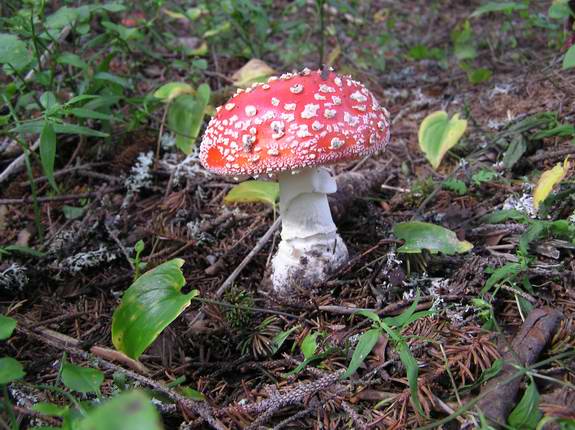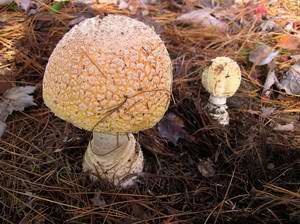|
Return to Hiker's Notebook Home Page
Common Name: Fly Agaric, Fly Amanita - The toxic properties of the mushroom were reportedly used to ward off flies, though there is some question as to the veracity of this assertion (discussed below).
Scientific Name: Amanita muscaria - The generic name is taken directly from the Greek word amanitai, which may refer to Mount Amanus in northern Syria; the use of Amanita is attributed to Claudius Galenus (better known as Galen), the noted Greek physician, who, according to Charles McIlvane in 1,000 American Fungi, used the term to describe 'esculent fungi.' The Latin word for fly is musca whereas the derivative muscaria means related to flies , reference to the aforementioned use of the mushroom to kill flies.
Amanita muscaria is surely the most recognizable mushroom in the Kingdom Fungi. It is the epitome of the genre, the bright red cap with contrasting white dots like a beacon against the backdrop ocher and verdant hues of the forest floor. Its use as the quintessential toad stool, frequently depicted with the eponymous amphibian squatting in apparent total disregard for predators on the vermillion, aerial perch, has made it the subject of countless worthless tchotchkes and colorful nursery decorations. Facile identification coupled with a wide geographic dispersion - it is found on every continent except Antarctica - have both contributed to the global notoriety of the mushroom. The so-called fly agaric has figured prominently in the cultures of many regions and is accordingly a matter of some ethnological interest.
The designation of the Amanita muscaria as a fly-killer is steeped in historical traditions that date to the early Renaissance. Saint Albert Magnus, the noted Dominican bishop, prolific Aristotelian author, and defender of Thomas Aquinas, wrote in his 13th Century book "De vegetabilibus (Of the Plants)" that the well known red and white mushroom was used by northern, Germanic tribes, for killing flies by crushing it in a bowl of milk. As this apparent article of faith preceded the classification scheme of Carolinas Linnaeus, the dipteran lethality of the mushroom was etymologically institutionalized in its first scientific listing as Agaricus muscarius (later to be changed to the genus Amanita) in the taxonomic tome "Species Plantarum" in the 18th Century.
With the Renaissance came the use of the scientific method to validate hypotheses through experimentation. In the 18th Century, the noted French botanist Jean Baptiste Francois Pierre Bulliard, who did some of the earliest work in mushroom identification, conducted experiments with fly agaric to see if it did, in fact, kill flies. In finding that it did not, he proposed that the scientific name be changed to Agaricus pseudo-aurantiacus (sham gold-colored agaric) to dissociate with the fly- killing implication of the original name. The status quo prevailed, however, and the A. muscaria as fly-killer myth persisted to the extent that even the "Audobon Field Guide to North American Mushrooms" by Gary Lincoff asserts that "it has been used, mixed in milk, to stupefy houseflies." No one seems to have ever questioned why milk is a part of the purported insecticidal potion.
Experimental investigations taking advantage of advance chemical analysis began in the 1960's to identify the purported insecticides of the fly agaric. Chemical constituents which were identified first as ibotenic acid in 1964 and later as pantherine in 1965 were qualitatively attributed the necessary toxicity. However, follow-on quantitative experiments in 1970 and confirmed in 2000 found that the fly agaric did not kill flies, but rather caused them to buzz around as if intoxicated. The only experiments that have proven any coherent effect on flies is that the growth of the larvae of Drosophila melanogaster (the well known fruit flies of early genetic experimentation) was inhibited when they were fed powdered mushroom. There is accordingly no real compelling evidence for asserting that fly agarics kill flies but only that it may stupefy them so that they are easier to kill by the traditional methods.
The ecumenical association of A. muscaria with fly extermination across Europe and Asia in spite of dubious evidence that it has any measurable effect suggests that there must be some other explanation; The fly agaric is called amanite tue-mouche in French, fliegenpilz in German and мухомор in Russian, all of which basically mean 'kill fly.' One explanation that has been proffered is that the 'fly' in fly agaric does not refer to the insect, but to a cultural association between flies and the mental state of an individual. It is not hard to imagine in the Dark Ages of ignorance and superstition that the seeming clairvoyance of flies in escaping a well placed swat could only be anthropomorphic and that they must therefore be invested with chthonic powers. It may not be coincidental that Beelzebub, another name for Satan, means 'Lord of the Flies' and that flies are agents of the devil. As madness was seen as being possessed by the devil, a logical explanation would be that flies had penetrated the brain and possessed it with their demonic proclivities. The syllogism is obvious: if the strange looking red and white mushroom causes behavior characteristic of madness similar to the effect attributed to flies, then the mushroom must be related to flies and it is therefore appropriate to call it the fly agaric - that is the mushroom that causes madness. But does it? That depends on the geography, the chemistry of species, and on other factors not yet well understood.
There are three chemicals associated with A. muscaria that are related to its toxic and psychoactive effects: muscarine, ibotenic acid and muscimol. Muscarine was first isolated from it in 1869 and was originally thought to be the cause the observed neurological effects of ingestion. Later research determined that muscarine was a minor constituent of the A. muscaria (~ 0.0002 weight percent) but was a major constituent in several mushrooms in the Inocybe and Clitocybe genera (~ 0.1 - 0.4 weight percent) . Muscarine consumption results in excessive salivation and lactation followed by vomiting and diarrhea that can, in severe cases, lead to respiratory failure and death. Ibotenic acid and muscimol are currently thought to be the primary compounds responsible for the mushroom-induced human behaviors of the fly agaric. The are closely related, since muscimol (C4H6N2O2) is derived from ibotenic acid (C5H6N2O4) by dehydration induced decarboxilation. However, many other compounds have been isolated ranging from adenosine to xanthin that may contribute to a combined effect.
The symptoms of A. muscaria ingestion range from mild hallucinations to gastrointestinal distress. The most prevalent description is of psychotropic effects that result from eating one mushroom that become manifest from thirty minutes to one hour after ingestion. A confused state accompanied by lightheadedness succeeds to distortions of space, heightened visual and aural sensitivity and an unawareness of time - similar it would seem to the standard cannabis effect. After two hours, tiredness and drowsiness are followed by a deep sleep with vivid dreams that lasts about eight hours. David Aurora in "Mushrooms Demystified" reports that nausea and vomiting are common and that "an inordinate number of trippers seem to think they are Jesus Christ," but that "most people, including myself do not wish to repeat the experience." On the other hand, Charles McIlvaine in "One Thousand American Fungi" finds that A. muscaria is "undoubtedly poisonous to a high degree," since, when its juices were injected into an etherized cat, it resulted in death in less that a minute (it is only implied that he personally conducted this experiment). In spite of this indictment, he apparently tried it, reporting that a small piece of a cap had a noticeable effect if taken on an empty stomach but that the nicotine from a pipe led to an abatement of the symptoms in about two hours, leaving only a "torturing, dull, skull-pervading headache." The New York Times reported in 1897 that a certain Count Achilles de Vecchi and a colleague, both members of the Mushroom Club of Washington (State), believed that A. muscaria was wrongfully maligned as poisonous and accordingly ate what was reported as copious quantities with the result that "both men were taken violently ill and Count Vecchi succumbed."
The Amanita muscaria has a long history of human cultural association and the resultant ethnomycology ranges from its well established use as an hallucinogen to some imaginative theories about its use in early religious practices. The various tribes inhabiting the northern regions of Eurasia known as Siberia have long used the mushroom primarily as a part of religious ceremonies, their holy men known as shamans obtaining a trance-like state that was thought to provide them with god-like perspicacity. Among certain tribes, it was the custom for the inebriated shamans to urinate into a vessel that was consumed by their celebrants who became similarly, though less intensely, manic. This is consistent with the chemical interactions of gastric fluids with the ibotenic acid and muscimol that are thought to be the cause of hallucinations - some of these compounds will pass through the body unaffected. This has been confirmed with samples of human urine taken one hour after mushroom consumption and validated by the conduct of experiments with mice. The use of A. muscaria in shamanistic rituals is still practiced by the Ostyak, Vogul, Kamchadal, Koryak and Chukchi tribes of Siberia. One of the more fanciful theories is that the shamans would dress up in red and white costumes to mimic the mysterious magic mushroom from which their power derived - this serving as the basis for the legend of Santa Claus complete with the flying reindeer.
The various theories connecting Amanita muscaria with early religious
practices is based on a syllogistic association. Its crimson hue made it easy
for a Stone Age forager to find and identify in a time when the paucity of
food precipitated experimentation. It is therefore likely that the mushroom
was discovered early in human history when animism was the prevalent spiritual
belief and that its hallucinogenic, heightened perception effects were
attributed to deistic influence. Thus, the mystical experiences of the Ancient
Greeks at Eleusis, the eponymous Eleusian Mysteries, have been attributed to
it. Plato and Aristotle, among many others, are known to have participated in
the ceremonies, where the congregants entered the Telesterion (Great Hall of
Mysteries), there to be administered the Kykeon, a potion of mystical powers,
that they swore on pain of death never to reveal. One biblical scholar at
Manchester University has offered the theory that Jesus of Nazareth attained
his spirituality by consuming mushrooms and that his disciples comprised a
veritable mushroom cult. Others have sought to assert mushroom consumption
by just about every biblical personage from Adam to Ezekiel. It is more
plausible though not likely that the ritualistic "Soma" spiritual beverage
of the Aryan conquerors of India in about 1500 BCE was made from powdered
Amanita muscaria.
The substantive differences in the effects that result from eating Amanita muscaria ranging from mild discomfort to death in physical terms and from mildly narcotic to transcendental in spiritual terms are due to the variability of the mushroom chemistry according to geographic and local environmental conditions. There are three distinct clades of the species that are described as Eurasian, Eurasian sub-alpine and North American. All three clades are found in Alaska, contributing to the thesis that the species originated there and spread via the Beringian Isthmus in the Tertiary Period. In eastern North America, the primary variant is the yellow-orange sub-species A. muscaria var formosa, which tends to be more toxic and less hallucinogenic than its crimson cousin, which is found in the West. . |

